What We Do
- Mission: Offering high-quality non-alcoholic beverages that boost energy;
- Target: Teens and Millennials (Poindexter, 2012);
- Location: Houston, TX;
- Opportunity: High market saturation (Hill, Jones, & Schilling, 2014);
Competitive Advantage:
- Goals: 10% annual growth.
To establish a foundation for discussion, Edge Incorporated specializes in offering new generation energy drinks that not only boost energy levels and have exceptional flavors but also are ecologically friendly and contain no artificial additives. Due to these aspects of the product, the company mostly targets at teens and Millennials, as these consumer groups are eager to try and explore innovative offers of the market (Poindexter, 2012). The company will start its operations in Houston, TX. Generally speaking, similarly to all B2C models, it will increase its profits by gaining the attention of consumers and enlarging its market shares by ensuring their constant retention. This aspect makes it similar to its major competitors such as PepsiCo and Coca-Cola that occupy 70% of the market, but their market sizes tend to become smaller due to intensifying competition and high market saturation (Hill et al., 2014). Nevertheless, apart from these entry barriers and challenges, Edge Incorporated will succeed in the market not only due to the exceptional taste and eco-friendliness but also with the help of the management’s ability to develop an associated lifestyle and promote health. To achieve these goals, Edge Incorporated will rely on exceptional experience and knowledge of our team of experts and the principles of digital marketing. Overall, our main goals are 1) 10% financial growth during the first and second years and 2) having enough financial resources to expand and maximize profits continuously.
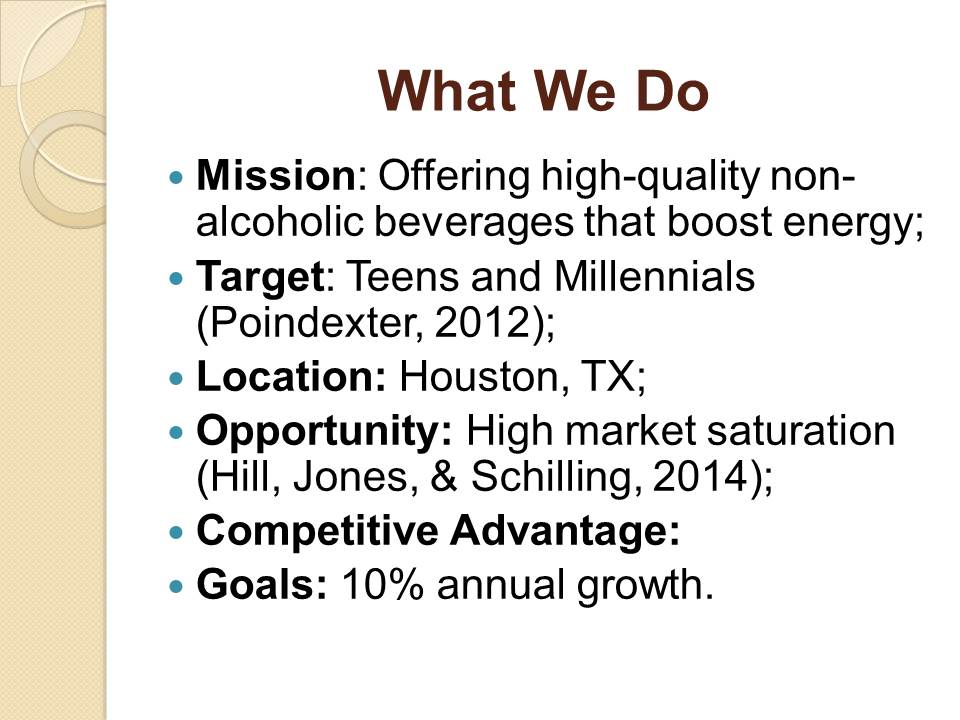
The Opportunity
- High consumption rates – 670 eight-ounce servings per capita in 2013 (Bailey, 2014);
- Rising health concerns (Reece et al., 2013);
- Popularity of social media among teens and millennials;
- Possibilities for geographical expansion.
A primary rationale for having a desire to start operations in this market pertains to high consumption rates that are 670 eight-ounce servings per capita in 2013 (Bailey, 2014). Even though these numbers are not as high as before, another favorable aspect is rising health concerns, as more and more people devote their attention to the dieting habits and sports (Reece et al., 2013). Along with that, focusing on social media and its popularity among teens and millennials is an advantage and opportunity to pursue, and it will lead to subsequent growth and geographical expansion in 2020.
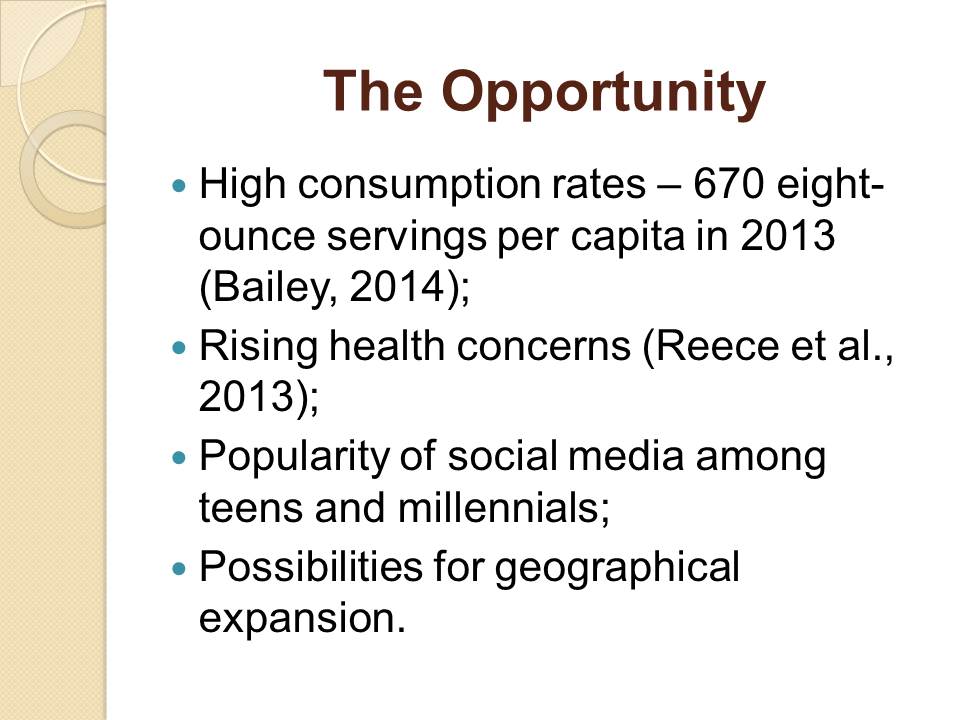
Target Market
B2C:
- 12-30 years old teens and millennials;
- 400,000 customers in Houston, TX, during the first year (U.S. Census Bureau, 2015);
B2B:
- Local farms.
In the previous slides, it is referred to that the main target groups are teens and Millennials. Nonetheless, they have to be 12-30 years old, and it accounts for 400,000 customers in Houston, TX (U.S. Census Bureau, 2015). Along with that, the potential customers in the B2B segment will be local farms.
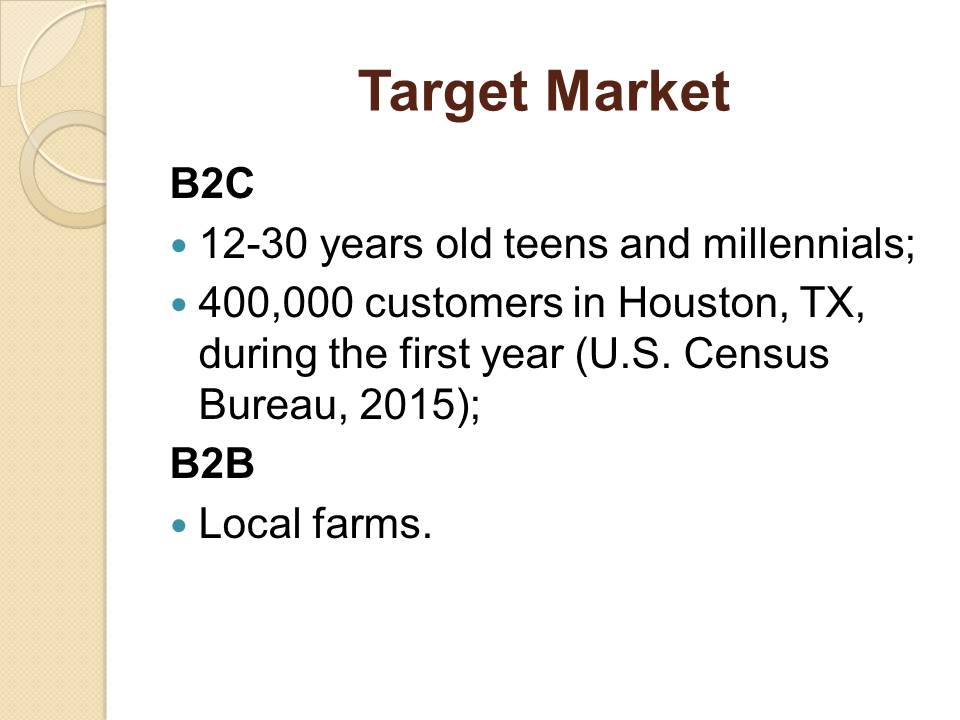
Market Size
Generally speaking, the whole soft drinks beverage industry accounts for 840 billion dollars (Bailey, 2014). Meanwhile, in the USA, the consumption of these beverages remains high with 670 eight-ounce servings per capita (Bailey, 2014). Along with that, the expected 25% growth of middle class is another definer of prosperity and growth of the industry, as this aspect will increase household expenditures and, as a consequence, attract more players to this market.

Competition
Competitive Advantages
- Innovative idea;
- Focus on eco-friendliness;
- No artificial ingredients;
- Variety of flavors.
Apart from vehemently growing market size, the competition is intense. For example, 70% of the market is occupied by international giants such as Coca-Cola and Pepsi. Nonetheless, due to the rapid growth of the industry, currently, 25% of the beverage market consists of Dr. Pepper, Snapple, Red Bull, and Monster, and 5% of it is represented by the local producers. At first glance, it may seem that the current competitive environment is unfavorable for new entrants, but having innovative idea, variety of flavors, and no artificial ingredients and focusing on eco-friendliness are the major competitive advantages that can help Edge Incorporated grow continuously and gain more and more loyal customers.
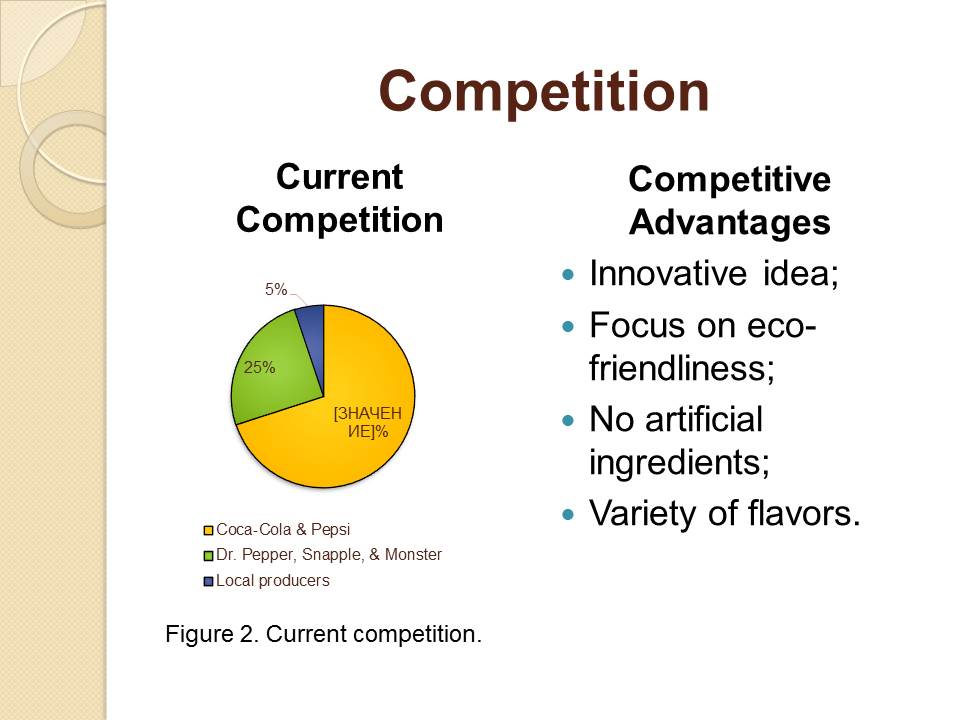
The Team
Current Personnel
Scott E. Connors: CEO:
- Previous experience in B2C marketing;
Stephen Job: Computer expert:
- Outstanding experience in computation of manufacturing;
Melinda Cates: EDGE organic energy drink creator:
- Previous positive experience in marking and selling EDGE;
Advisory
Ian Glass: volunteer/consultant:
- 35 years of professional experience as PepsiCo plant production foreman;
Mary Cates: consultant:
- Ex-senior executive of Federal Trade Commission.
Nonetheless, to overcome the competition, it is necessary to have a qualified team of experts. Our company consists of me, Stephen Job (computer expert), Melinda Cates (EDGE organic energy drink creator), Ian Glass (consultant), and Mary Cates (consultant). Hiring these individuals is rational, as only a combination of their unique skills and experiences will assist the company in differentiating it from the competitors while taking advantage of know-how and digitalization.
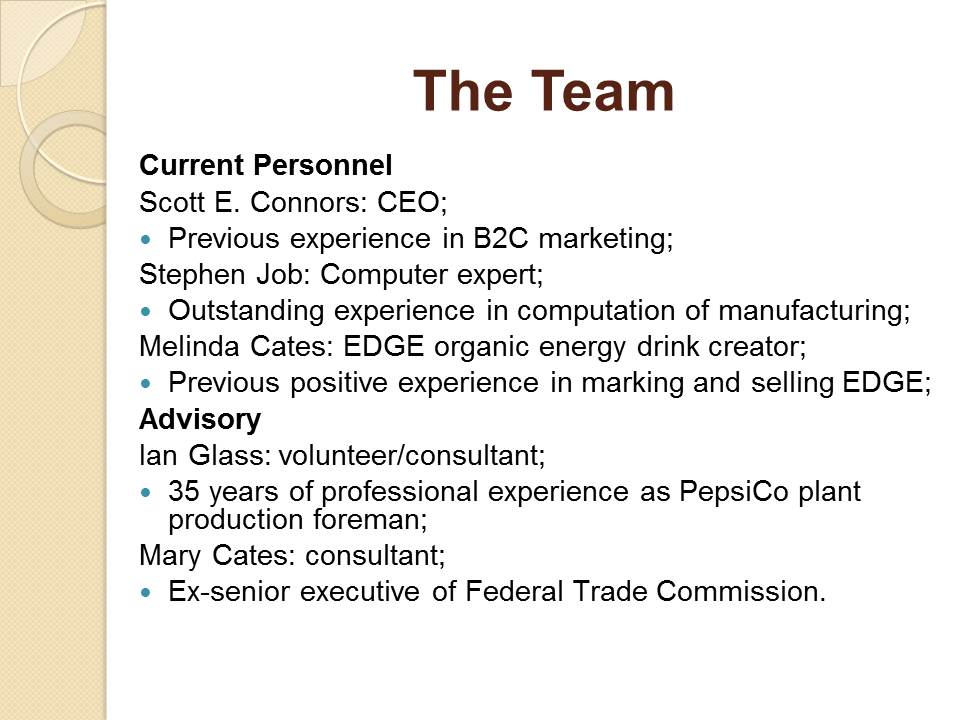
Business Model
B2C
- Niche marketing;
- Reasonable price-to-quality ratio;
- Social media marketing (Baruah, 2012);
- Advertising via farmers.
B2B
- Corporate Social Responsibility;
- Offering a unique platform for collaboration;
- Direct contact and trade fairs such as Houston Job Fair and Houston Gordon Food Service Show (10times, 2017; TSNN, 2017).
As it was mentioned earlier, this product will target at mostly teens and Millennials, but also at individuals, who may be interested in healthy lifestyle. This strategy can be referred to as niche marketing while the company will also attempt to create a reasonable price-to-quality ratio. Due to the specifics of the target audience and its behavior, social media marketing can be viewed as the most suitable tool that cannot only inform consumers about new offers and services but also assist in cultivating and promoting healthy habits (Baruah, 2012). A combination of these factors along with distributing information via farmers will help retain consumers in a B2C segment. As for B2B, the company will attract farmers by its corporate social responsibility and its ability to provide a unique platform for collaboration. In turn, the company will seek partners by contacting them directly and having a presence at trade fairs such as Houston Job Fair and Houston Gordon Food Service Show (10times, 2017; TSNN, 2017).

Milestones
- January, 2017 – launched;
- January, 2018 – purchasing additional equipment;
- January, 2019 – expected 10% growth;
- December, 2018 – expected 10% growth;
- 2020-2021 – geographical expansion and growth (stable client base);
- 2021 – net profit of more than $1,000,000.
Overall, the company will pass the following stages: 1) being launched in January, 2017; 2) purchasing additional equipment; 3) having 10% financial growth in 2018; 4) having a 10% increase in profits in 2019; 5) expanding its areas of operation in 2020-2021; and 6) having net profit of more than $1,000,000. In this case, this sequence of steps implies that the company will continue its slow growth and have bright future.
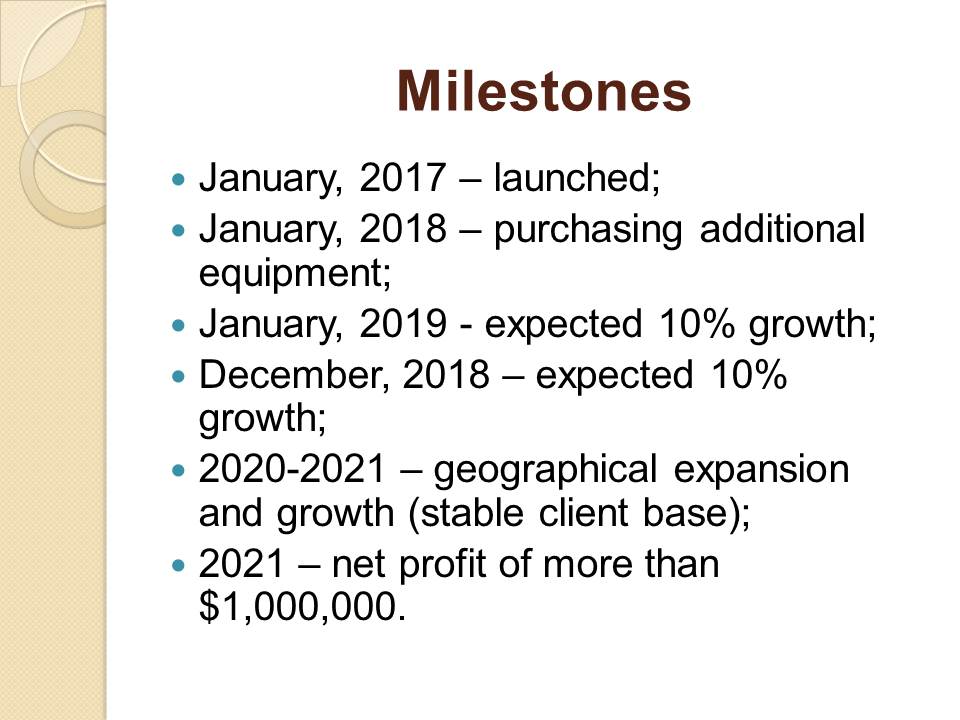
Financials
In turn, the primary goal of this slide is to provide important insights regarding company’s financial performance. This figure shows that company’s financial performance will remain positive. This factor signifies the firm’s positive dynamics and slow growth of its market share. Nonetheless, gross profit will account for $20,000 on average, but having it at this value will allow the company to stay viable and competitive in the market.
It remains apparent that it is also of paramount importance to describe company’s financials with a five-year timeframe. In this instance, the figure displayed on the slide clearly shows positive dynamics and an upward shift in gross sales, gross profit, and net profit. It is depicted that net profit in 2017 is rather low, but this value is enough to ensure company’s financial viability, liquidity, and solvency. Along with that, it is a positive sign for investors while implying that Edge Incorporated is the company to be considered for both short and long-term investments.
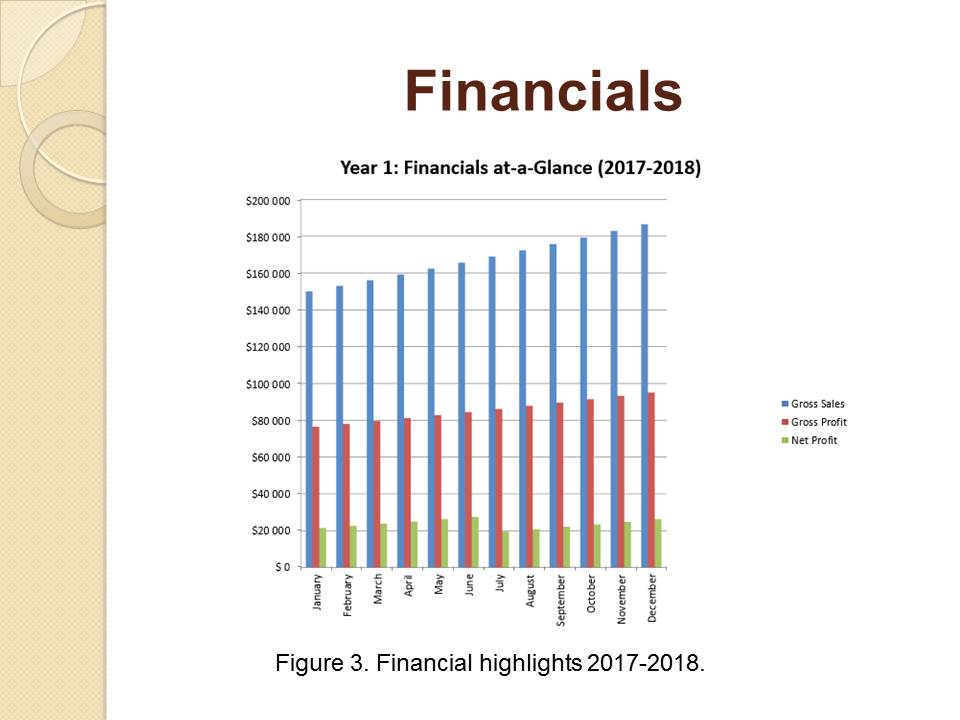

Funding
Funds Sought
- $200,000 (for equipment purchases).
Current Funding
- $40,000 (Melinda Cates);
- $5,240 (inventory);
2 future funding rounds.
Apart from the fact that financial forecasts signify a positive trend in the organizational financial performance, additional funding is required. Currently, the company has $40,000 provided by Melinda Cates and $5,240 in inventory. Nonetheless, it will not be enough for purchasing additional equipment such as Mixer Beverage Filling Machines and Accutek AccuSnap Capper Bottling machines. In this instance, it will be rational to have $200,000 in additional funding to cover these expenses. This investment will help the management of Edge Incorporated balance its cash flows while two additional future funding rounds may be required to support business growth and development.
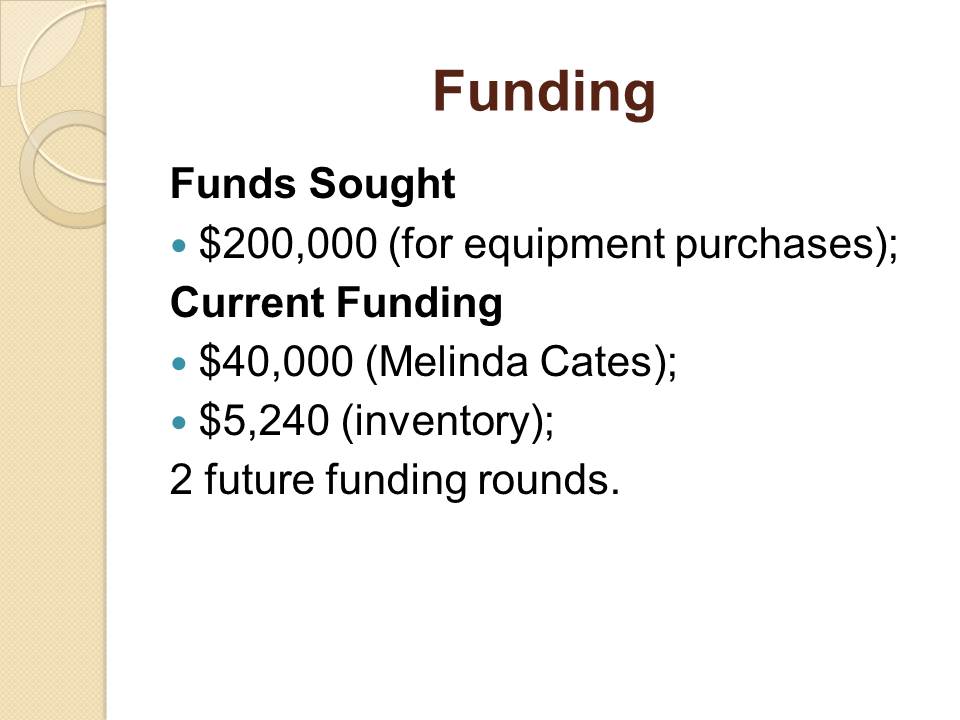
The Upside
- Positive revenues and net profits;
- Possibilities to grow within 5-10 years;
- Favorable economic environment;
- Wisely selected market niche and management team;
- Unique product;
- Highly saturated competition and only 5% local rivalry;
- Strong future potential and financial viability.
Overall, I hope that my presentation convinces you that Edge Incorporated is a favorable opportunity for investment. Nevertheless, it is essential to summarize its key benefits that include positive revenues and net profits, opportunity to grow within 10 years, wisely chosen market niche and employees, unique product, highly saturated competition, and strong future potential and financial viability. Thank you for your attention, and I think that I provided you a substantial number of insights to make a wise decision and become more socially responsible.
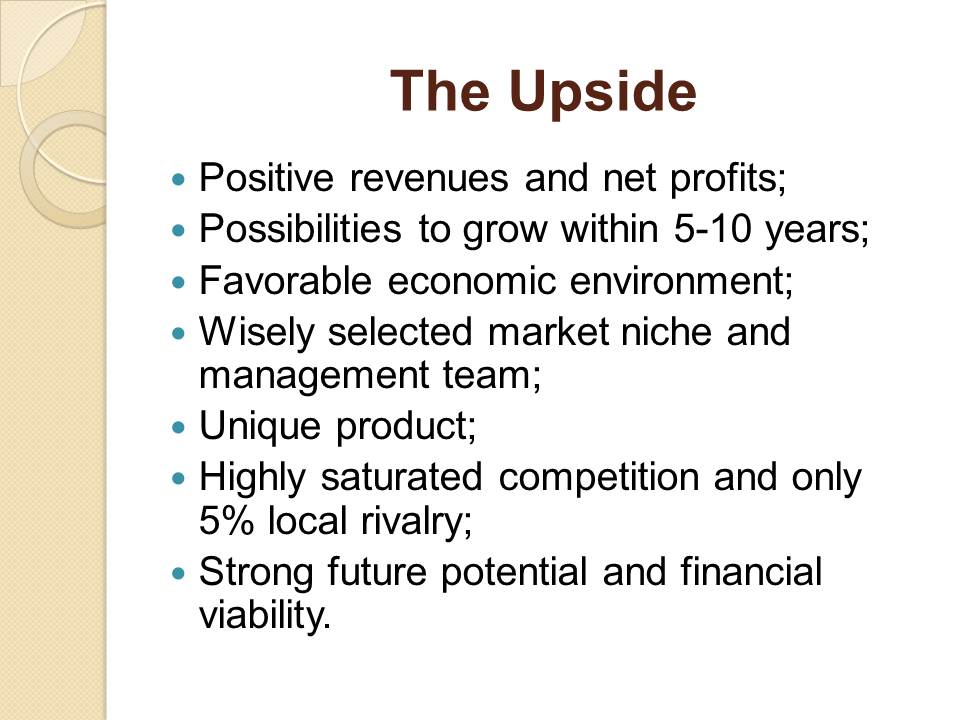
References
10times. (2017). Trade shows in Houston. Web.
Bailey, S. (2014).Why growth is sluggish in non-alcoholic beverage industry? Web.
Baruah, T. (2012). Effectiveness of social media as a tool of communication and its potential for technology enabled connections: A micro-level study. International Journal of Scientific and Research Publications, 2(5), 1-10.
Hill, C., Jones, G., & Schilling, M. (2014). Strategic management: Theory and cases: An integrated approach. Boston, MA: Cengage Learning.
Poindexter, P. (2012). Millennials, news, and social media: Is news engagement a thing of the past? New York, NY: Peter Lang Publishing Group.
Reece, M., Tasner, M., Davila, T., Epstein, M., Shelton, R., Light, L., & Kiddon, J. (2013). How to innovate in marketing. Upper Saddle River, NJ: FT Press.
TSNN. National Angus Convention and trade show 2017. Web.
U.S. Census Bureau. (2015). 2015 population pyramid. Web.